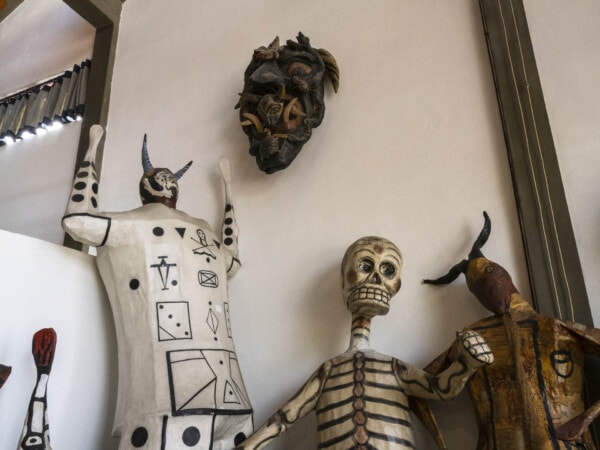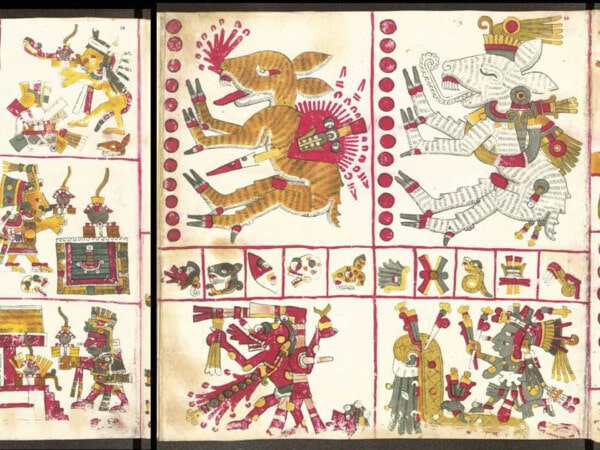In art galleries, at markets and on street corners in Oaxaca, you see all sorts of alebrijes, brightly coloured Mexican sculptures of fantastical creatures, simple and affordable, refined and expensive, mass-produced and trinketty, the state’s signature souvenir in a range of sizes, techniques and colours. More than eight-hundred families in the villages of Arrazola, Tilcajete and Tejalapam make their living by creating what has become the cultural symbol of Oaxaca.
A shepherd boy, a piñata-maker and a tourist—the story of alebrijes is as unreal as the dreamed-up mythical wooden creatures themselves.
Having read a thin sketch of the story of their origin, I emailed our guide, Balam Ruiz, asking him to arrange a visit to an Oaxacan village where alebrijes (pronounced “al-lay-bree-hahz”) are made.
The story of alebrijes begins with an an eight-year-old Zapotec boy, Manuel Jiménez.
With idle time on his hands while watching over his family’s sheep grazing at the foot of Monte Alban, Manuel began using clay to make miniatures of the animals he saw around him every day: rabbits, coyotes, donkeys, goats, and dogs. When he saw how the rain ruined his clay figures, he turned to carving them from wood.
Life was hard for Manuel. He worked a variety of jobs before becoming the “shepherd” of the archaeological zone of Monte Alban, safeguarding newly excavated works. Once again, Manuel had time on his hands, so he resumed carving, making animal figures as well as masks and nativity scenes. He sold his artwork door-to-door in Oaxaca for a few centavos.
When Tomb 7 was discovered at Monte Alban in 1931, tourists began visiting Oaxaca. One of them was Arthur Train, who, recognizing Manuel’s talent, bought one of the boy’s figures for 50 cents—then resold it in New York for $200!
Around this time in Mexico City a cartonero named Pedro Linares Lopez who specialized in making piñatas fell ill. Fevered and in a delirious sleep, Pedro had a dream that he’d regained his health and was transported to a strange forest where the rocks, clouds and trees transformed into fantastical creatures: lions with eagle heads, bears with butterfly wings, all shouting “Alebrijes, Alebrijes, Alebrijes.”
Although Pedro had been a piñata-maker of Judas figures and masks from the age of twelve, his work was mostly unknown. After he recovered, that changed.
Pedro began creating papier-mâché models of the surreal animals he had seen in his dream, calling them alebrijes. His work entranced people, including Frida Kahlo and Diego Rivera who commissioned Pedro to create alebrijes for their homes in Mexico City, where we saw their eerie, loose-limbed bodies, their faces mocking death.
At the time Pedro’s art took this new direction who should come to Mexico City but Manuel. Encouraged and accompanied by Arthur, Manuel presented his surreal carvings to the Tourist Council, where the officials named them after the closest thing they resembled—the fantastical alebrijes that Pedro was making from papier-mâché. Pedro became Manuel’s teacher. And Manuel became Pedro’s most notable student, surpassing his teacher by evolving the concept of alebrijes into what it is today.
Having experimented with different woods, Manuel settled on copal: durable, easy to carve, cherished, its oddly curved branches suggestive of animalistic forms. Unlike Pedro’s chimera-like creatures, Manuel began to base his alebrijes on Zapotec Nagualism, the belief that a human can access power and spiritual insight by connecting with the tonal animal within. For centuries the Zapotec have had a tradition of giving each newborn baby a nagual, a talisman in the form of animals from the twenty-month Mesoamerican calendar to wear for a lifetime of good luck and protection. (Have a look at the Navigation section below to find your “spirit” nagual.)
Manuel refined his carving of fantastical creatures, exquisitely detailed, vividly coloured, each one unique, and in the 1950s he encouraged and taught other wood carvers to imagine and create their own whimsical combinations.
Fame arrived for both artists in the 1970s. For Pedro in 1975 with a documentary film about him. For Manuel in 1978 when his work won first place in an arts festival in Los Angeles, where he was awarded the title International Grand Master. Until Manuel died in 2005 at the age of 86, he devoted his life to making alebrijes.
Balam had put Arrazola on our itinerary. I hadn’t told him of my desire to see the master’s alebrijes (which I thought would be impossible anyway) so what a surprise to find he’d arranged a visit to Manuel’s former home, now El Tallador de Sueños, a museum-workshop!
In a room filled with a collection of alebrijes staring at us from behind glass cases and looking up from the floor, Manuel’s presence in their compelling vitality, his own eyes looking out from framed photographs and newspaper articles, I believe it was one of his grandnieces who interrupted her lunch to tell us his story, in Spanish and translated by Balam.
What a dreamlike experience to be in the modest, understated workshop of the founder of this style of art that continues to influence so many Mexican artists, art that continues to be created here by his extended family. To lock eyes with Manuel’s phantasmagorical figures, one that pierced my being with such profundity, casting a spell over me that still leaps into view when I daydream of that afternoon in Arrazola.
Navigation
Like us, you can take this fun quiz from El Silencio Mezcal to answer the question, What is my alebrije? when you enter your birth date and year. I’m a dominator fish/opossum spirit: “You have the power to bewitch and incline the hearts of others, you are bold and observant with a forceful and energetic temperament. But, you never stop moving and you struggle to be stable and still. Wield the power of seduction with caution and find stillness or face consequence.” Magellan is a celestial chameleon/owl. “You are tender, affectionate and unbound by ego. You care for your family and your home, always making others smile But, you hesitate to trust and wobble incessantly with indecision. The game cannot be won if the player is influenced by doubt.” And it gives you a mezcal drink recipe! Magellan’s looked best: 2 oz mezcal, 1 oz lime juice and ½ oz agave syrup garnished with a lime strip and cherry and served in a salt-rimmed glass.
FOFA (Friends of Oaxacan Folk Artists) for more about Manuel’s family and the alebrijes they’re creating today.
Mexplorer Adventures Balam is a superb guide. He and his wife Patty have their own company, Mexplorer, with a fleet of cars and drivers. We didn’t know about Mexplorer and found Balam at Gyde & Seek.
“What Are Alebrijes: A Guide to Oaxaca’s Colorful Art [2023]” Shelley at Travel Oaxaca.



























5 Responses
Interesting and colourful (pun intended) story. Pinatas have been an integral part of our grandchildren’s birthdays for over a decade. Usually they have been some sort of animal form and are very cartoonish. The kids love them. Problem is now some of the grandkids are over 6 feet tall and the Pinata almost goes into orbit.
Did they create a special one for Grandpa’s big birthday last month?
The colours are splendid, but the creatures may give bad dreams!
We could use more of those fantastic colours in our lives. Long ago a friend told me that I should not wear my navy clothes all the time, darn.
What colour combinations did you like best for these fantastic creatures? What colour combinations would you like to wear?
There is a couple creating very contemporary alebrijes whose work is shown at the gallery Linked in our Nav. They are gorgeous, very refined and detailed work done like Warhol’s factory; their design, other artisans carrying out the work, my faves the ones that were done in Mexican turquoise blue/greens. However, I prefer the rustic work of the past where you can see the carving strokes and the colours are few—like my wardrobe perhaps.
Interesting human animalistic concoctions to be sure, the colours and adornments push my thoughts to other Mexican and South American drugs that might drive this form of expression.
Almost like a Psychedelic dream, in more ways than one, creativity knows no boundaries when the human mind and soul is twisted beyond normal reality, of course first we must define normal.
Love the colours and creature definitions the artist has provided, like a tornado of visions.